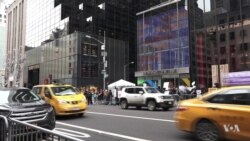Silicon Valley isn’t the only place to find the next Mark Zuckerberg. Nearly 9,000 tech startups call New York City home, and their offerings reflect the unique needs of the most populous U.S. city.
At the recent NY TechDay event in New York, more than 500 startups were on hand to display their wares. The event was billed as the largest in the United States and a mix of founders, funders and tech-curious individuals were among the estimated crowd of 35,000.
“The city moves at its own speed, right? And we always want to maximize our time,” said New Yorker and startup founder CJ Bertram. He was discussing how Looop, his mobile app, fits into the hectic lifestyle of New Yorkers.
Looop connects with sensors placed in local restaurants and bars to let users know how crowded or busy these establishments are at any given time.
Like many ideas, Looop was born out of necessity. Early on, Bertram and his team were often challenged to find coffee shops with enough space to work in.
“We couldn’t find seats or we watched people come in and the line was long and they left,” said Bertram.
“It’s about the room. We wanted to optimize the room ... it can benefit the person that’s traversing towards that room and the person that owns that room.” Bertram hopes to develop an API [application programming interface] that will allow Looop to run on multiple interfaces, including digital assistant platforms like Apple’s Siri and Amazon’s Alexa.
Portable power
Running out of battery power for mobile devices is another common problem for on-the-go New Yorkers. Leo Tawilian and his partners started Hoplite Power as a solution.
The co-founder and president of the New York-based startup is building a network of kiosks that dispense portable battery chargers.
Users pay $2.99 for the use of a charger for one day. Chargers can be returned at any time to any Hoplite kiosk. An extra $1.99 is charged for each additional day the charger is checked out.
“What we’re offering is a convenience. Most people who have portable batteries have several of them sitting in the dresser somewhere, tucked away, not being used,” noted Tawilian, “You still have to remember to charge those batteries, bring the wire, carry it with you everywhere you go ... and most people forget to do that.”
“For New Yorkers and others around, mobility is key. We figured if there are bike-sharing systems and car-sharing systems, why can’t we create a power-sharing system?” he added.
3-D medicine
New York neurosurgeon Osamah Choudhry is also harnessing technology to shake up his industry. The CEO of MediVis hopes to bring holographic visualization to medicine.
“We’re so used to preparing for surgical operations using two dimensional CAT scan and MRI data,” said Choudhry, “Our healthcare students are used to learning anatomy and physiology and pathology using two dimensional atlases and text-based data,” he added.
“We want to take all of that and bring it into the world of holographic visualization, so we can have much more powerful and immersive learning.”
Using Microsoft’s HoloLens, a wearable holographic computer, MediVis’ software allows doctors and medical students to interact with 3-D, augmented reality models of the human body.
Besides providing doctors and medical students with a new platform for engagement, Choudhry believes holographic visualization can also improve patient experiences.
“Patients deserve to see and know about their medical issues in a way that’s most intuitive to them. They cannot read CAT scans or MRIs, but they can be presented holographic visualization which gets them on the same page as their physicians.”














